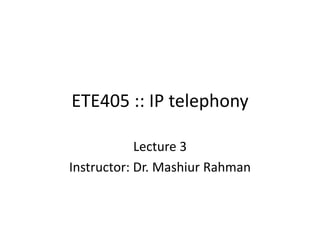
ETE405-lec3.pdf
- 1. ETE405 :: IP telephony Lecture 3 Instructor: Dr. Mashiur Rahman
- 2. Chapter 1 Book:: Cisco - Voice over IP Fundamentals
- 3. Overview of the PSTN • Public Switched Telephone Network (PSTN) has been evolving ever since Alexander Graham Bell made the first voice transmission over wire in 1876.
- 5. N × (N–1)/2. the telephone users needed only one cable to the centralized switch office, instead of seven.
- 6. Centralized Operator: The Human Switch
- 7. Understanding PSTN Basics Analog and Digital Signaling
- 8. Analog and Digital Signaling • Analog communication is ideal for human interactoin. – Not robust – Not efficient for recovering noise from line. • Amplification was needed for communication. Analog waveform
- 11. Digital Voice Signals • PCM is the most common method of encoding an analog voice signal into a digital stream of 1s and 0s. All sampling techniques use the Nyquist theorem , which basically states that if you sample at twice the highest frequency on a voice line, you achieve good-quality voice transmission.
- 12. Local Loops, Trunks, and Interswitch Communication
- 13. Local Loops, Trunks, and Interswitch Communication • The telephone infrastructure starts with a simple pair of copper wires running to your home. This physical cabling is known as a local loop . • The local loop physically connects your home telephone to the central office switch (also known as a Class 5 switch or end office switch). • The communication path between the central office switch and your home is known as the phone line, and it normally runs over the local loop. • The communication path between several central office switches is known as a trunk .
- 15. PSTN Signaling • User-to-Network Signaling: twisted copper pair as the transport, a user connects to the PSTN through analog, Integrated Services Digital Network (ISDN), or through a T1 carrier. • The most common signaling method for user- to-network analog communication is Dual Tone Multi-Frequency (DTMF) . DTMF is known as in-band signaling because the tones are carried through the voice path.
- 17. •The tone frequencies, as defined by the Precise Tone Plan, are selected such that harmonics and intermodulation products will not cause an unreliable signal. •No frequency is a multiple of another, the difference between any two frequencies does not equal any of the frequencies, and the sum of any two frequencies does not equal any of the frequencies. •The frequencies may not vary more than ±1.8% from their nominal frequency, or the switching center will ignore the signal. • The high frequencies may be the same volume or louder as the low frequencies when sent across the line. •The loudness difference between the high and low frequencies can be as large as 3 decibels (dB) and is referred to as "twist." •The minimum duration of the tone should be at least 70 msec, although in some countries and applications DTMF receivers must be able to reliably detect DTMF tones as short as 45ms.
- 18. out-of-band ISDN uses another method of signaling known as out-of-band . With this method, the signaling is transported on a channel separate from the voice. The channel on which the voice is carried is called a bearer (or B channel) and is 64 kbps. The channel on which the signal is carried is called a data channel (D channel) and is 16 kbps. Figure shows a Basic Rate Interface (BRI) that consists of two B channels and one D channel.
- 19. Network-to-Network Signaling • T1/E1 carrier over twisted pair – T1 is a 1.544-Mbps digital transmission link normally used in North America and Japan. – E1 is a 2.048-Mbps digital transmission link normally used in Europe. • T3/E3, T4 carrier over coaxial cable – T3 carries 28 T1s or 672 64-kbps connections and is 44.736 Mbps. – E3 carries 16 E1s or 512 64-kbps connections and is 34.368 Mbps. • T4 handles 168 T1 circuits or 4032 4-kbps connections and is 274.176 Mbps. • T3, T4 carrier over a microwave link • Synchronous Optical Network (SONET) across fiber media • SONET is normally deployed in OC-3, OC-12, and OC-48 rates, which are 155.52 Mbps, 622.08 Mbps, and 2.488 Gbps, respectively.
- 20. PSTN Numbering Plans • North American Numbering Plan (NANP) – Numbering Plan Area (NPA, also referring to as area code), Central Office Code (NXX), and Station Number • the International Telecommunication Union Telecommunication Standardization Sector (ITU- T; formerly CCITT) International Numbering Plan – E.164 specifies that a Country Code (CC), National Destination Code (NDC), and Subscriber Number (SN)
- 21. Summery of lecture 3